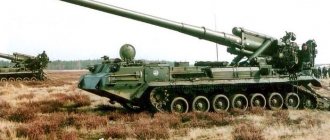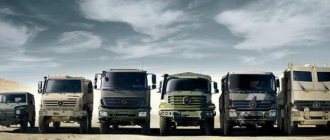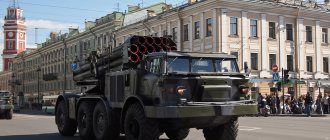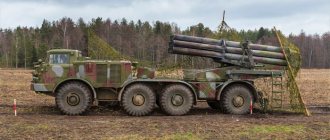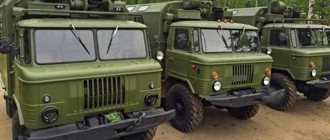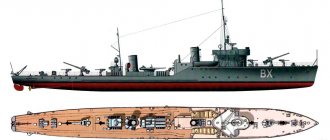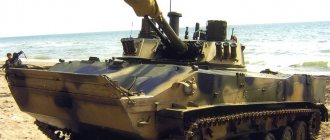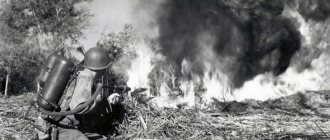The exhibit, called MAZ 543, was developed as the best all-wheel drive vehicle, which in design did not differ from its world analogues. The most interesting thing is that this four-axle giant is created exclusively from domestically produced parts.
Initially, the engineers were faced with the task of developing a missile carrier; later the 543rd base became universal for a wide variety of systems and additional equipment. As a result, the heavy vehicle became one of the most popular in the USSR military-automotive complex.
The appearance of a new Soviet military vehicle MAZ-543
After the Minsk Automobile Plant mastered the production of MAZ 537 series, a group of engineers was sent from Yaroslavl to Minsk, whose task was to develop a new military vehicle, using the base and developments that were used to create the MAZ-537.
The MAZ-543 car began to be developed at the end of the 1950s. For this purpose, special design bureau No. 1, under the leadership of Shaposhnikov, used all its knowledge accumulated since 1954. With the help of engineers from Yaroslavl, by 1960 the MAZ-543 chassis project was ready. The Soviet government responded very quickly to this news and on December 17, 1960, issued a decree that obliged the production of the MAZ-543 chassis to be launched as soon as possible.
After 2 years, the first 6 samples of the MAZ-543 chassis were ready. Two of them were immediately sent to Volgograd, where experimental missile launchers and R-17 ballistic missiles with a liquid-propellant jet engine were installed on the MAZ-543 chassis.
The first completed missile carriers were sent to the test site in Kapusny Yar in 1964, where the first design tests were carried out. During the testing process, the MAZ-543 chassis showed its good side, since SKB-1 had experience in developing similar vehicles since 1954.
User manual
Taking into account the originality of the design and operating features of the chassis, the manufacturer recommends that in order to ensure reliable and safe operation, you carefully study the operating instructions and impeccably follow all its requirements. Drivers who have studied and passed exams on knowledge of the technical base, safety measures and driving of this type of equipment are allowed to drive a vehicle.
The crew consists of 2 people. After receiving a new car, it needs to be run in. After the first 1 thousand kilometers, fastening work corresponding to maintenance (TO-1) is performed, and the fastening of the central gearboxes to the frame is also checked. Every 2 thousand kilometers, the first 2 oil changes in the tank are carried out.
Before starting the engine, pump the lubrication system with an electric oil pump at a pressure of at least 2.5 kgf/cm². The pump must not be kept running for more than 1 minute, and the starter cannot be kept in the on position for more than 5 seconds. It can be turned on again after 25-30 seconds.
If the air temperature is below 5°C, the crankshaft is not cranked and the engine is not started without preheating. After turning on the heater, after 1-2 minutes, check by touch for uniform heating of the boiler. Once the unit has finished operating, restarting is possible after 30 minutes. After washing at an ambient temperature below 5°C, it is started for 3-5 minutes to remove water from the blower.
After the vehicle has been parked for a long time at -15°C, when the lubricating fluid thickens, the hydromechanical transmission with overdrive is turned off.
When driving, gear changes in the planetary gearbox are carried out sequentially from high to low. When driving on a good road in second and third gears, the torque converter is blocked. Reverse gear is engaged after the vehicle has come to a complete stop. When driving on paved roads or on dry dirt roads, the transfer case engages a direct gear, and when driving in difficult conditions, a reduction gear is engaged.
Forced stopping of the machine on uphill or downhill slopes with a slope of more than 7° requires the use of not only the hand brake, but also a mechanical drive of the right master brake cylinder, and parking on the drive should not exceed 4 hours, otherwise mountain stops are installed: on the uphill - under both wheels rear axle, on a descent - front axle.
All models of military MAZs are not intended for civilian transportation and economic needs. They are manufactured in small series only according to government orders for the needs of the army. Cars are not sold or rented on the secondary market. Therefore, the price and rental cost are impossible to know.
An unexpected decision regarding the choice of cabin layout for the MAZ-543
The new missile system, called Temp-s, had a very long missile (12,380 mm), so the chassis length was clearly not enough. It was decided to make a special recess in the middle of the cabin, but this could not be implemented. Since all that remained was to lengthen the frame, chief designer Shaposhnikov made a very bold and extraordinary decision - to divide the large cabin into two isolated ones, between which the head of the rocket was located.
Such a division of the cabin has never been used on such equipment, but this method turned out to be the only correct solution. Subsequently, most of the predecessors of the MAZ-543 had cabs of this type. Another original solution was the use of new material to create the MAZ-543 cabins. They were not made of metal, but of polyester resin, which was reinforced with fiberglass.
Although there were immediately many skeptics who argued that it was unacceptable to use a material resembling plastic for the cabin, tests of the cabin proved the opposite. During testing under shock load, the test stand collapsed, but the cabin itself survived.
Mounted armor plates were developed specifically for the cabin. Since the MAZ-543 had to fit into the railway format, the cabins received 2 seats each, and the seats were not located in a row, but one after another.
Modern MAZs
MAZ 543 (MAZ 7310 or “Hurricane”) was replaced over time by the “Oplot” family of vehicles. True, their production never took the form of “serial production”. They were designed to carry even more powerful weapons. Thanks to the creation of their predecessors, it was possible to produce new road trains capable of transporting loads of 75-100 tons. Designer B.L. Shaposhnik was awarded the title of Hero of Socialist Labor. He became a laureate of the Lenin and State Prizes of the USSR. Now all manufactured products are marked MZKT instead of the usual MAZ.
Car models are produced for collectors in Kazan on a scale of 1 to 43. They are made of metal and plastic. In the game "Truckers" they used the MAZ 7310 model to create the "Storm" truck. And in the game Spin Tires the same vehicle was called E 7310.
Technical characteristics of MAZ-543
When designing the MAZ-543, many original design solutions were used:
- The original frame consisted of 2 bent spars of increased elasticity. For its production, welding and riveting technologies were used;
- In order to ensure the necessary smoothness, an independent torsion bar type suspension was chosen;
- The transmission was also very original. The four-speed hydromechanical gearbox made it possible to change gears without interrupting power;
- The vehicle's cross-country ability was ensured by 8 drive wheels, each of which had an automatic inflation system. By adjusting the tire pressure, it was possible to achieve high cross-country ability even on the most difficult off-road areas;
- The D-12A-525 tank engine provided the vehicle with the necessary power reserves. The volume of this 12-cylinder 525 horsepower engine was 38,880 liters;
- The car had 2 fuel tanks with a capacity of 250 liters each. There was also an additional aluminum tank with a capacity of 180 liters. Fuel consumption could range from 80 to 120 liters per 100 km;
- The chassis load capacity was 19.1 tons, and the vehicle's own weight was about 20 tons, depending on the modification.
The dimensions of the MAZ-543 chassis were dictated by the dimensions of the rocket and launcher, so they were indicated in advance in the technical specifications:
- The length of the MAZ-543 was 11,265 mm;
- Height – 2,900 mm;
- Width – 3,050 mm.
Thanks to the separate cabins, it was possible to place the Temp-S launcher on the MAZ-543 chassis without any problems.
Engine and gearbox
MAZ 543, whose technical characteristics are similar to MAZ 537, also has a similar engine, but with direct fuel injection and an air purifier. It has a V-shaped arrangement of twelve cylinders, a mechanical all-mode speed controller, and runs on a diesel engine. The prototype of the diesel engine was the B2, used in tanks during the war. The volume is 38.8 liters. Engine power – 525 hp. With.
The hydromechanical transmission used in the MAZ 543 makes driving easier, improves off-road capability and engine durability. It consists of three parts: a four-wheel drive, a single-stage torque converter, a three-speed automatic transmission and a control system.
The car has a mechanical transfer case, which has two stages with a center differential.
Basic model MAZ-543
The very first representative of the MAZ-543 family of vehicles was a base chassis with a payload capacity of 19.1 tons, which was called MAZ-543. The first chassis under this designation were assembled in the amount of 6 copies in 1962. In total, 1,631 copies were produced throughout the entire history of production.
A number of MAZ-543 chassis were sent to the GDR army. There they were equipped with tented all-metal bodies, which could be used both for transporting goods and for transporting personnel. Additionally, MAZs were equipped with powerful towing devices, which turned them into powerful ballast tractors. Those vehicles that were not used as tractors were converted into mobile workshops or repair and recovery vehicles.
The MAZ-543 was originally created to accommodate tactical missile systems on its chassis. The first complex that was placed on the MAZ-543 chassis was “TEMP”. After this, a new 9P117 launcher began to be mounted on the MAZ-543 chassis.
The following complexes and systems were also installed on the MAZ-543 base:
- Coastal missile system "Rubezh";
- Combat control points;
- Special military truck crane 9T35;
- Communication stations;
- Diesel autonomous power plants.
There were also other specific equipment mounted on the MAZ-543 base.
Post-war period
After the end of World War II, the USSR seriously began developing domestic heavy tractors for the army and the developing national economy. In 1951, the Yaroslavl automobile plant mastered the production of three-axle YAZ-210G vehicles with a platform and a powerful winch. It was not possible to organize large-scale production of these vehicles, and besides, the tractors could not go off-road, especially during the rainy season or spring thaw.
Thus, the tasks of creating heavy vehicles still required solution, especially since rapid industrial construction was unfolding in the country, and strategic missile systems were emerging in the military department, which needed mobility. Armored forces also needed reliable heavy-duty tractors.
Features of MAZ-543A
In 1963, an experimental modification of the MAZ-543A chassis was produced. This model was intended for installation of the Temp-S OTRK SPU. The MAZ-543A modification began to be produced in 1966, and serial production was launched only in 1968.
Especially to accommodate the new missile system, the base of the new model was slightly increased. Although at first glance no differences are visible, in fact the designers slightly increased the front overhang of the car, moving the cabins forward. Thanks to an increase in the front overhang by 93 mm, it was possible to lengthen the useful part of the frame to 7 meters.
New modifications of the MAZ-543A were primarily intended for installation of the Temp-S launcher and the Smerch multiple launch rocket system on their bases. It is noteworthy that although the Temp-S launchers have long been removed from service with the Russian Ground Forces, the Smerch multiple launch rocket systems are still in service with the Russian army.
The MAZ-543A modification was produced until the mid-2000s. In total, about 2,600 chassis were produced over the years. Subsequently, the following equipment was installed on the MAZ-543A chassis:
- Truck cranes of various lifting capacities;
- Command posts;
- Communication complexes;
- Power plants;
- Various workshops.
In addition to the above, other specific military equipment was installed on the MAZ-543A base.
Main modifications
Today there are two main models and several small-scale versions.
MAZ 543 A
In 1963, the first modernized version of the MAZ 543A was introduced, with a slightly increased payload capacity to 19.4 tons. A little later, namely from 1966, based on modification A (hotel), they began to produce different variations of military equipment.
As such, there are not many distinctive features from the base model. The first thing you notice is the cabins moved forward. This made it possible to increase the useful length of the frame to 7000 mm.
It must be said that the production of this version was massive and lasted until the early 2000s. In total, no more than 2,500 pieces rolled off the assembly line.
Basically, the vehicles served as missile carriers for transporting missile weapons and all kinds of equipment. In general, the chassis was universal and was intended for the installation of superstructures of various types.
MAZ 543 M
The golden mean of the entire 543 line, the best modification, created in 1974. Unlike its predecessors, this car had only one cabin on the left side. The carrying capacity was the largest; it was up to 22,200 kg without taking into account the weight of the car itself.
Overall, no major design modifications were observed. On the basis of the MAZ 543 M, the most formidable weapons and all kinds of additional superstructures were produced and are still being created. These are the Smerch SZO, the S-300 air defense system, etc.
Over the entire period, the plant produced at least 4.5 thousand units of the M series. With the collapse of the USSR, serial production was stopped. All that remained was the production of small batches ordered by the state. By 2005, a total of 11,000 of all possible variations based on the 543 family had rolled off the assembly line.
On the chassis, a military truck with an all-metal body, the MAZ 7930, was developed in 1990, on which a more powerful engine (500 hp) was installed. The launch of mass production of the version, called MZKT 7930, did not stop even the collapse of the USSR. The production continues to this day.
Small-scale modifications
Over the more than 50 years of this model's history, various modifications have been produced in limited quantities. Serial production was not established, because there was no need for it.
For example, the MAZ 543 B was designed to transport the improved 9K72 missile launcher. For the mass M series, the basis was the prototype of the B series.
For economic needs and logistics support, modifications with the P index were produced. These were training and firefighting vehicles or models for transporting trailers and heavy artillery pieces. There are about 250 pieces in total.
Often, as part of a road train consisting of two-axle tractors MAZ 5433 and serial number 8385, you can find the on-board module MAZ 543 7310 and some other models.
A small batch of MAZ 543 Hurricane was also designed for fire services. These giants can still be found today on the take-off sites of the CIS countries. The fire fighting equipment was equipped with a water tank with a capacity of 12 thousand liters and a tank with a foaming agent of 900 liters.
Such machines were indispensable for extinguishing fires at such facilities. The main disadvantage of all cars in this series is high fuel consumption. If the first models consumed up to 100 liters per 100 kilometers, then modern versions consume up to 125 liters for the same distance.
Various prototypes and small-scale vehicles produced on the basis of the MAZ-543
Since modernized launchers with increased dimensions appeared in the early 70s, the question arose about the development of new modifications of the MAZ-543 chassis. The first experimental development was the MAZ-543B, assembled in two copies. They served as a chassis for installing the modernized 9P117M launcher.
Since new launchers required a longer chassis, a modification of the MAZ-543V soon appeared, on the basis of which the MAZ-543M was designed in the future. The MAZ-543M modification was distinguished by the presence of only one cabin, which was significantly moved forward. Such a chassis made it possible to place larger installations or equipment on its base.
For various transport operations both in the army and in the national economy, a small-scale modification of the MAZ-543P was developed. This machine was dual-purpose. It was used both for towing trailers and artillery pieces, and as training vehicles.
There were also virtually unknown modifications that were produced in single copies as experimental models. These include the MAZ-543D modification, which has a multi-fuel diesel engine that could run on both diesel fuel and gasoline. Unfortunately, due to the complexity of production, this engine never entered mass production.
Also interesting is the MAZ-543T prototype, the so-called “Tropic”. This modification was specifically designed for use in mountainous and desert areas.
Features of MAZ-543M
In 1976, a new, most popular modification of the MAZ-543 appeared. The prototype model, which was named MAZ-543M, was tested for 2 years. This car was put into service immediately after its debut. This modification has become the most successful in the MAZ-543 family. Its frame was the longest in its class, and the vehicle's load capacity was increased to 22.2 tons. The most interesting thing about this model was that all the components and assemblies were absolutely identical to the components of other models of the MAZ-543 family.
The most powerful Soviet launch systems, anti-aircraft launch systems and various artillery systems were installed on the MAZ-543M chassis. Various special add-ons were also installed on this chassis. During the entire production period of the MAZ-543M modification, more than 4,500 units of cars were produced.
Of great interest is the list of specific support equipment installed on the MAZ-543M chassis:
- Mobile dormitories designed to accommodate 24 people. These complexes have ventilation, microclimate, water supply, communications, microclimate and heating systems;
- Mobile canteens for combat crews.
These cars were used in remote areas of the USSR, where there were no settlements or places to live.
After the collapse of the Soviet Union, mass production of MAZ-543 vehicles of all three modifications was practically discontinued. They were produced strictly to order in small batches until the mid-2000s.
In 1986, the license to assemble the MAZ-543 was sold to the Chinese company Wanshan, which still produces them.
MAZ (SKB)/MZKT(MAZ/MZKT)
Minsk USSR/Belarus 1954-
Since the mid-50s. The Minsk Automobile Plant (MAZ) was the main research and production center of the USSR, where heavy all-wheel drive vehicles for the Soviet army were developed and produced. The decision to organize a special design bureau No. 1 (SKB-1) at the recently commissioned plant to create fundamentally new cars was made by the Council of Ministers of the USSR on June 25, 1954 as part of the resolution on the organization of special design bureaus at all major automobile and tractor factories of the USSR for the design of military equipment. The Minsk Design Bureau was headed by Boris Lvovich Shaposhnik (1902-1985), who worked before the war as the chief designer of the Moscow ZIS automobile plant.
Tractor MAZ-528, 4x4, 1955
Ballast tractor MAZ-535A, 8x8, 1958
Tractor MAZ-538 (IKT-S), 4x4, 1960
MAZ-535A with R-36 intercontinental missile, 1968
At MAZ in the late 40s. he took up the development of a mining dump truck. The first 25-ton MAZ-525 was assembled in the fall of 1950, proving the young enterprise’s ability to create unconventional types of super-heavy wheeled vehicles.
Initially, the main task of SKB was to develop 4-axle tractors for towing heavy artillery systems, but they soon served as the basis for unique multi-axle chassis for strategic missile systems and heavy weapons, which had high mobility and the ability to move over almost any terrain and in any weather conditions, surpassing a number of parameters of tracked vehicles. In terms of their capabilities and workmanship, at one time they represented the best examples of Soviet automotive technology, but for a long time information about them was classified as “secret”.
The first vehicle manufactured at SKB in 1955 was the MAZ-528 (4x4) tractor with a 165-horsepower YaAZ-206 diesel engine, designed for towing trailers and working with a bulldozer blade. It became the prototype of the universal 375-horsepower MAZ-538 (4x4) tractor, known as the IKT-S medium engineering wheeled tractor. Its features were a hydromechanical gearbox, suspension of the front steered wheels on a rigid balancer, non-suspension mounting of the rear wheels and a cabin with double-sided controls.
When equipped with various attachments, it was used as a PKT wheeled track layer and a TMK trench digger, and could also work with a variety of equipment when moving both forward and in reverse. In 1956, a prototype of the MAZ-529 single-axle tractor was built to work as part of a self-propelled scraper. Having passed acceptance tests, in 1958 the MAZ-529V version with a two-stroke 120-horsepower diesel engine YaAZ-M204A and a 4-speed gearbox was accepted for mass production at the Mogilev Automobile Plant (MoAZ). In the 60s it was used as a tractor-installer of strategic missile systems to the launch position and towing heavy equipment.
In the first period, the main task of SKB was to create 4-axle tractors MAZ-535 and MAZ-536 (8x8) for towing artillery systems weighing 10 and 15 tons, respectively, but with the formation of the priority of the Soviet army for more powerful vehicles for delivering armored vehicles and mounting heavy missiles armament work on the 536th model was replaced by the design of the MAZ-537 truck tractor. For their production, in the spring of 1959, the Production of Special Wheeled Tractors (PSKT) was established at MAZ.
MAZ-537 (8x8) with R-9A intercontinental missile, 1958/66.
Launcher 9P117M of the 9K72 missile system on the MAZ-543 chassis, 8x8, 1965.
Launcher 9P120 of the 9K76 "Temp-S" missile system on the MAZ-543 chassis, 8x8, 1966.
The first prototype of the MAZ-535 tractor was built in 1956, a year later the “535A” version with a reinforced frame appeared, produced until 1969 and used for towing artillery pieces, ballistic missiles and heavy equipment. He laid the foundation for the design of most of the heavy machines that followed him. Behind its steel 4-seater cabin was a diesel engine D-12A V12 (38880 cm3, 375 hp) with direct fuel injection, four valves per cylinder and two overhead camshafts in each block, which was a modification of the famous tank engine AT 2. The transmission of its own design included a torque converter, a planetary 3-speed gearbox, a 2-speed transfer case, center and cross-wheel self-locking differentials and planetary wheel gearboxes.
The suspension was an independent torsion bar suspension with hydraulic shock absorbers, the two front axles were controlled using a hydraulic booster, single-pitch wheels were equipped with tube tires with a centralized system for regulating internal pressure (from 0.7 to 2.0 kgf/cm?). A characteristic external feature of a number of cars was a third headlight in the center of the front panel, which served to illuminate the road
for night vision device. The tractor had a wheelbase (the distance between the outer axles) of 5770 mm, a body with 7 tons of ballast and a 15-ton winch, a speed of 60 km/h, and overcame slopes of 30° and a 1.3-meter ford. The 535B saddle version was distinguished by a balanced suspension of the rear axles without elastic elements, the absence of a winch and a tire inflation system. The semi-trailer it towed housed a launching unit for launching the Tu-123 reconnaissance aircraft of the Yastreb complex.
The more powerful MAZ-537 truck tractor was intended to work with low-load semi-trailers for the delivery of tracked vehicles weighing up to 50 tons, heavy weapons and missiles as part of road trains with a total weight of up to 75 tons. It differed from the “535B” model by increasing it to 525 hp. engine power, wheelbase 5600 mm, new tires and control station. The “537G” and “537D” tractors were equipped with a winch and an electric generator, respectively, and the MAZ-537A was a ballast tractor. The equipment of the prototype of the first missile launcher was mounted on the “537B” experimental chassis. His tests proved that wheeled launch systems are almost always, except in rare cases, superior to tracked ones, which opened the door for the production of such equipment. In 1963, the design documentation for the MAZ-538 tractor was transferred to the Kurgan Wheel Tractor Plant (KZKT), and in 1964 to the MAZ-537, which allowed SKV MAZ to concentrate on the production of more modern military equipment.
In 1960-61 In SKV, the first versions of 4-axle vehicles of the second generation for mounting heavy weapons were created, which are still produced. The basic one was the 19-ton MAZ-543 (8x8) chassis, which for a long time served as the basis for the entire subsequent program. Its main advantages were its low dead weight, widespread use of high-alloy steels, and a reinforced riveted-welded frame with increased elasticity, made of thin low-alloy steel sheet.
MAZ-543A chassis with TUAP-2 launch container installer
Launcher 9A52-2 of the 9K58 “Smerch” multiple rocket launcher system on the MAZ-543M chassis, 8x8, 1988.
Launcher 5P85SU of the S-300PMU missile system on the MAZ-543M chassis, 1989.
The chassis had a wheelbase of 7.7 m (the distance between the middle axles is 3300 mm, the base of both bogies is 2200 mm), an independent torsion bar suspension on all wheels and a tire pressure regulation system (1.0-3.5 kgf/ cm2). The car was designed to operate at temperatures from -40 to +50 °C, and was externally distinguished by two 2-seater fiberglass cabins with ventilation, heating, noise insulation and intercoms. On November 7, 1965, at the parade in Moscow, launchers 9P117M of the 9K72 operational-tactical missile system, mounted on a MAZ-543 chassis with a hydraulic lifting device for bringing an 11-meter ballistic missile into firing position and two additional control cabins located on both sides, appeared for the first time sides of the car between the middle axles. On the same chassis, but without side cabins, the equipment of the 9P120 launcher of the 9K76 “Temp-S” complex was mounted.
In 1965, a prototype of the MAZ-544 truck tractor was built, working with a MAZ-5246 semi-trailer with hydraulic wheel drive for mounting even heavier equipment. In 1966, production began of the MAZ-543A multi-purpose chassis with an increased installation area due to rearrangement of the engine compartment. It installed equipment for transporting and reloading missiles and missile containers into silo launch wells, command complexes and combat duty support facilities, including field canteens and dormitories. This chassis served as the base for the 9T234-2 transport-loading vehicle (TZM) with a hydraulic crane for loading 12 rockets into the 9K58 Smerch multiple launch rocket system.
Since 1976, a special 22-ton MAZ-543M chassis with a total weight of 43.5 tons was produced for mounting heavy weapons and combat equipment, which was externally distinguished by one left 2-seater cabin and a rearranged engine compartment with components and systems partially located in place of the right cabin , which made it possible to further increase the useful installation area. The most famous weapon on this chassis was the 9A52-2 launcher for the most powerful domestic multiple launch rocket system 9K58 “Smerch”, created in 1987 at the Splav State Research and Production Enterprise under the leadership of A. N. Ganichev and produced at Motovilikha Plants JSC In Perm. It is mounted on a rotating platform and consists of 12 tubular guides for launching 800-kilogram 300 mm caliber rocket projectiles at a distance of up to 70 km, hitting an area of 63 hectares.
The chassis is equipped with an additional cabin for the crew and control systems, as well as hydraulic supports for hanging the rear of the vehicle when firing. The MAZ-543M also carries the 130-mm Bereg artillery system, the Rubezh coastal defense missile system and the S-300P series anti-aircraft guns of the air defense forces, developed at the Almaz Central Design Bureau. At the turn of the 80~90s. For the S-ZOOPMU and S-ZOPMU-1 complexes on the “543M” chassis, the main and additional launchers 5P85SU and 5P85DU with containers for 4 missiles were developed, capable of simultaneously hitting several targets flying at a speed of 4300 km/h at an altitude of 25~27 km. Since 1997, their modernized versions have been used for the S-300PMU-2 Favorit complex, which hits 36 targets at once, as well as for the new, more effective S-400 Triumph system.
Launcher 5P85TE2 of the S-300PMU-2 “Favorit” complex on the MAZ-543M chassis, 1997.
RK-55 missile system on MAZ-79111 chassis, 8x8, 1978.
Tank carrier MAZ-74101, 8x8, 1978
MAZ-74103 truck tractor with TZ-90 tanker, 1978.
In 1970, according to the requirements of a military customer, the design of even more powerful third-generation Oplot tractors with a payload of up to 22 tons began, equipped with a 650-horsepower D-12A diesel engine, a hydromechanical 4-speed gearbox, reinforced suspension and high-ply tires. load capacity. These works were led by the deputy chief designer of SKB-1, Vladimir Efimovich Chvyalev. Prototypes of new equipment passed the necessary test cycle and were put into service. In 1978, production of the 7911 chassis began,
“79111” and “79112”, intended to replace models “543”, “543M” and “543A”, respectively. This range also included the “7311” ballast tractor and the “7410” series of fifth-wheel vehicles. It included the basic tractor "7410", working with a tanker TZ-30 or a 30-ton semi-trailer with hydraulic wheel drive, a model "74103" with a saddle load of 27 tons for towing tankers TZ-60 and TZ-90, as well as a tank carrier "74101" with a third cabin for the crew of transported armored vehicles and a 3-axle semi-trailer with all steerable wheels. The 9A52 launcher and the equipment of the 9T-234 loading vehicle, the 9K58 Smerch multiple launch rocket system, as well as the new RK-55 heavy missile system were mounted on the chassis “79111” and “79112”. Due to technical problems and the unpreparedness of KZKT for mass production of new equipment, it was not possible to completely replace the second generation with the third.
A special page in the history of the domestic automotive industry is occupied by the multi-axle chassis of the Minsk SKV for transporting and launching ballistic intercontinental missiles, which entered service with the Soviet Strategic Missile Forces (Strategic Missile Forces).
Chassis MAZ-547V, 12X12, 1973
Chassis MAZ-547A, 12X12, 1972
Launch of the Pioneer strategic missile system on the MAZ-547V chassis, 1974.
Strategic missile system "Pioneer-3" on the MAZ-547A chassis, 12X12, 1985.
The first prototype of the MAZ-547 chassis (10×8) appeared in 1970, and in 1972-74. production of 58-ton chassis “547A” and “547B” (12×12) with an axle load of 15 tons, equipped with a 650-horsepower tank diesel engine B-38 V12, a hydromechanical 4-speed gearbox, and a number of parts made of titanium sheets and castings began , as well as independent hydropneumatic suspension for each wheel. The 547A model had two forward-moving cabins; the 547B chassis received a second operator cabin, shifted rearward. Vehicles with a length of more than 15 m could overcome slopes of 15° and a ford with a depth of 1.1 m, had a ground clearance of 475 mm, a turning radius of 22~25 m and a power reserve of 530 km. In full combat gear they could move at a speed of 40 km/h. These chassis, equipped with a control complex, powerful hydraulic supports and a lifting device for bringing missile weapons into combat position, served as the base for the first ground mobile launchers (GMPU), which carried out combat duty on the move, in any road and climatic conditions and therefore became practically invulnerable to enemy. Their equipment was developed and manufactured by Volgogradsky.
In the winter of 1976, the first Soviet mobile strategic missile system "Temp-2S" on the "547A" chassis entered combat duty. In March, the Pioneer complex on the 547B chassis with a transport and launch container for the RSD-10 medium-range ballistic missile (up to 4.7 thousand km) was put into service, modernized versions of which were introduced in the 80s. mounted on the “547A” chassis and the 710-horsepower “7916” with a carrying capacity of 63 tons. Both complexes became victims of the epic disarmament of the Soviet Union in the second half of the 80s: the first was liquidated under the SALT-2 treaty, the second in accordance with a bilateral agreement between USSR and USA on intermediate and shorter range missiles (RSD-RMD). The development of the 547 series vehicles in 1978 included the experimental “547B” chassis with an aluminum frame and the “547E” tractor with an 800-horsepower gas turbine and an electric generator that supplied current to 12 motor wheels.
Tractor MAZ-547E, 12X12, 1978
Missile system "Pioneer-3" on the MAZ-7916 chassis, 12X12, 1986.
Chassis MAZ-7912, 14X12.1979
Strategic missile system "Topol" on the MAZ-7917 chassis, 14X12, 1989.
In the mid-70s. The next stage in the development of multi-axle chassis began, when SKV specialists had to solve problems that had not been developed even in theory. They encountered the first problem when creating the MAZ-7912 chassis (14×12) in 1978 with an odd number of axles, when the entire load could fall on one middle axle, which was made non-driving with an increased suspension travel that could withstand a triple load.
The use of lightweight and durable materials made it possible to increase the ratio of the chassis load capacity to its own weight to a record value of 2.2. In 1985, under the leadership of V. E. Chvyalev, the new chief designer of UGK No. 2 of the Minsk Automobile Plant, production began of the 7-axle MAZ-7917 chassis (14x12) with a load capacity of 63 tons and a length of 17 m, equipped with a B-58 V12 diesel engine 710 hp and 8 front steered wheels. On these chassis were mounted the Start-1 missile systems for commercial launches of launch vehicles and the new Topol strategic complex with a 20-meter RS-12M intercontinental solid-propellant missile with a launch mass of more than 45 tons. Their first launches took place in the winter of 1983, and The Topol system was adopted for service in December 1988.
Chassis MAZ-7908, 8x8, 1986
Chassis MAZ-7929,10X8,1988
Chassis MAZ-7906, 16X16, 1984
Chassis MAZ-7904, 12X12, 1984
During the process of perestroika in the USSR, which brought conversion, the loss of large military orders and the collapse of the military industry, SKB MAZ continued to actively work on the creation of promising models of military equipment. Among them were the 36-ton chassis "7908" (8x8) with a 710-horsepower engine and hydromechanical transmission, the short-wheelbase 27.5-ton chassis "7909" (8x8) and the 35-ton "7929" (10x8), equipped with 420 - a strong diesel engine and a 9-speed manual transmission from the Yaroslavl Motor Plant (YaMZ).
Of greatest interest are the special-purpose multi-axle chassis that made up the Tselina-2 family and was used for the delivery of super-heavy cargo in units of the Strategic Missile Forces and at the Baikonur Cosmodrome. The most powerful and heaviest was the 220-ton chassis MAZ-7904 (12×12) with a total weight of 360 tons with an overall width of 6.8 m, equipped with a traction 12-cylinder marine diesel engine with a power of 1500 hp. and an additional 330-horsepower motor for power take-off, two hydromechanical transmissions and all single wheels with a diameter of 3 m.
The 150-ton chassis “7906” (16×16) received one 1500-horsepower power unit, and the most unusual Soviet vehicle can rightfully be considered the transporter “7907” (24×24) with a load capacity of 150 tons, which had 8 front and rear steered wheels . It was equipped with a tank gas turbine engine with a power of 1200 hp, which rotated an alternating current electric generator, from which current through thyristors was supplied to air-oil-cooled electric motors mounted on the frame and driving each wheel of this unique vehicle.
Chassis MZKT-7930, 8x8, 1998
Truck tractor MZKT-74295 with trailer “93783”, 1996
Truck tractor MZKT-742953 (8x8) with trailer “99943”, 2000
In 1991, after the formation of the independent Republic of Belarus, an independent enterprise was created on the basis of the production of wheeled tractors UGK-2 MAZ - the Minsk Wheeled Tractor Plant (MZKT), the products of which are known under the brand name “Vo-lat”. At a time of complete absence of military orders and government funding, which created a real danger of losing unique production, they developed a wide range of standardized all-wheel drive chassis of a modular dual-use design with units of domestic and foreign production. In the most difficult times, MZKT specialists did not forget about the new military technology
Nika, which developed the basic design principles of previous machines.
In the early 90s. To replace the “543” series, the MZKT-7930 (8x8) chassis with a lifting capacity of 22~24 tons appeared, produced since 1998 and in the early 2000s. adopted by the Russian army. It uses a 500-horsepower diesel engine YaMZ-846.10 V8 with turbocharging, a 2-disc clutch YaMZ-151 and a manual 9-speed gearbox YaMZ-202, as well as a new single-volume 3-seater cabin, which first appeared in 1988 on the chassis "7929". MZKT-7930 and its export version “79306” with a 544-horsepower Deutz diesel engine and an Allison automatic transmission are used for mounting the latest types of weapons and equipment. Among them are the 9P78-1E launcher of the Iskander-E high-precision operational-tactical missile system and a transport-loading vehicle for it, the Bal-E coastal defense missile system, and the 96L6E three-dimensional radar station for the S-300P anti-aircraft missile systems , heavy bridge laying machine TMM-6, headquarters complexes, etc. The “74106” (8x8) truck tractor, modernized in 1994, with a load on the coupling device of 23 tons, is used to tow the “9988” semi-trailer with a 64N6E detection radar, part of the C system -200 and S-300. At the same time, the modernized chassis “79161” (12x12) with a 710-horsepower diesel engine appeared.
Antenna post of the Pechora-2M complex on the MZKT-80211 chassis, 2002.
Launcher 5P73-2M of the Pechora-2M missile system on the MZKT-8021 chassis, 6x6, 2002.
Repair and recovery vehicle MZKT-790986. 8x8, 2003
Among the new models of military vehicles created in the second half of the 90s was a road train for transporting armored vehicles weighing up to 60 tons, consisting of an MZKT-74295 (8x8) truck tractor with an extended civilian cab with a berth and a low-load semi-trailer “93783”. The car is equipped with a 425-horsepower YaMZ-8424 diesel engine, a YaMZ-202 gearbox, front torsion bar and rear balance spring suspension. In 1997, a unique hooded tractor "74135" (8x8) with a 788-horsepower Deutz V12 diesel engine, an automatic 6-speed Allison transmission and a 4-door cab with a berth was manufactured for the UAE armed forces, which was tested with different semi-trailers. In 2004-06 options appeared with the Mercedes-Benz V12 engine with a power of 796 hp, designed to work with the 70-ton semi-trailer “99942” and the 60-ton trailer “83721” as part of a three-link road train with a gross weight of more than 205 tons and 38 m long, developing a speed of 82 km/h.
In 2002, the plant began producing a promising generation of cabover chassis for mounting military equipment and weapons. It is based on the basic models “8022” (4x4) and “8021/80211” (6x6) with a lifting capacity of 10.0 and 18.5 tons with single-pitch tires on all wheels, a hydromechanical 5-speed Allison gearbox and a frame located in the front overhang 2-seater cabin with air conditioning. Chassis “8021” and “80211” differ in the installation of a YaMZ diesel engine (400 hp) behind or under the cab, respectively; the “8022” version is equipped with a 250-horsepower power unit located under the cab. The three-axle chassis is used to mount the 5P73-2M launcher of the S-125-2M Pechora-2M anti-aircraft missile system and the antenna post; the UNK-2M control post is installed on the 2-axle chassis. The same cabin in a 7-seater version is mounted on the 742953 (8x8) truck tractor with a 680-horsepower Mercedes-Benz V8 engine, a 6-speed Allison gearbox and wide-profile tires with adjustable internal pressure.
When coupled with a 70-ton semi-trailer "99943", the road train with a total weight of 125 tons is capable of moving at a speed of 62 km/h. For transportation and reloading of containers, a 12-ton chassis “69272” (8x8) is used, for towing heavy weapons systems a 15-ton ballast tractor “74132” (8x8) with a 650-horsepower YaMZ-8401 V12 engine is used, and the base for heavy repair and recovery The vehicles are chassis “790986” (8x8), created in 2003, with a 544-horsepower Deutz diesel engine and a 13-ton hydraulic crane.
After the collapse of the USSR, units of the Strategic Missile Forces in neighboring countries were abolished, and the new democratic Russia adopted the doctrine of total disarmament. By this time, an even more powerful Topol-M strategic complex had already been created with RS-12M-2 missiles weighing 47 tons and a warhead length with nuclear warheads of about 18 m, which required fundamentally new GMPUs. As their base, MZKT proposed externally identical 8-axle chassis “7923” and “7922” (16×16) with hydropneumatic suspension, three front and three rear steering axles and two cabins located in the front overhang. The first used a 1000 hp gas turbine, an alternator and an electric transmission with oil-cooled synchronous electric motors. The second chassis “7922” with a YaMZ-847.10 V12 diesel engine (25.9 l, 800 hp) and a hydromechanical 4-speed gearbox in 1995 was adopted as the base of the new mobile launcher “79221” (16x16). The times of economic reforms caused irreparable damage to the military-industrial complex of Russia: silo-based Topol-M missiles entered service only at the end of 1997, their test launches from the GMPU began in September 2000, and the decision to assign them the status of the basis of nuclear Russia's potential and the most advanced Russian weapons of the 21st century took place in 2003 after an adjustment in military priorities. The deployment of new systems at GMPU began in 2006.
Chassis MZKT-79221, 16X16, 1995
Launcher of the Topol-M missile system
Launcher of the Topol-M missile system on the MZKT-79221.16X16 chassis, 2003.
Table of contents
Fire trucks MAZ-543 “Hurricane”
MAZ-543 Hurricane fire trucks were designed specifically for service at Soviet airfields. Many vehicles of this series are still in use at CIS airfields. Firefighters MAZ-543 have a water tank of 12,000 liters. There is also a 900 liter foam tank. Such characteristics make these vehicles indispensable assistants in the event of a sudden fire at the airfield. The only drawback is the high fuel consumption, which reaches 100 liters per 100 km.
Currently, cars of the MAZ-543 family are gradually being replaced by new MZKT-7930 cars, although this process is going very slowly. Hundreds of MAZ-543 continue to be on combat duty in the armies of Russia and the CIS.
